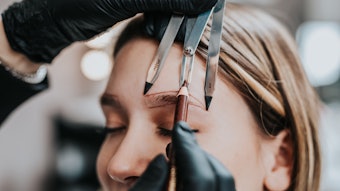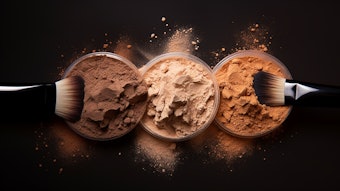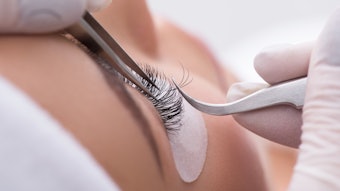
It’s no secret women want it all: cosmetics that feel good, look great and last long. Oh, and are good for the skin, too. Sound impossible? Not with the emergence of two-in-one treatment makeup that lets consumers enjoy the benefits of powerful skin care active ingredients in color cosmetics.
Log in to view the full article
It’s no secret women want it all: cosmetics that feel good, look great and last long. Oh, and are good for the skin, too. Sound impossible? Not with the emergence of two-in-one treatment makeup that lets consumers enjoy the benefits of powerful skin care active ingredients in color cosmetics.
The trend is driven by two major preoccupations in
the cosmetics market: antiaging and naturals. Makeup brands
with antiaging benefits have induced a $39 million
growth in the category in the past two years, according to market information provider Mintel.
In the U.S. alone, the makeup market grew by 6% from 2001 to 2006, totaling $6 billion in sales last year. This dynamic growth reflects the fact that specific areas of the segment are growing faster than others, primarily due to products that incorporate antiaging and natural ingredients in sophisticated ways.
As women pay more attention to what they put on their faces, formulators are challenged to create increasingly sophisticated product forms that answer consumer needs beyond color. With the maturity of the facial makeup market and the rising number of brands in the marketplace, innovation is the key to getting into women’s makeup bags.
Ingredient
Innovation
As consumers look beyond the visual effects of makeup, brands expect innovation in a wide
range of cosmetic technologies.
Niche specialty chemicals company Perstorp has made a bid to make its mark on the
cosmetics and personal care industry with the in-cosmetics 2007 introduction of a palette of intermediate
materials—predominately targeting the antiaging and male grooming markets. The company’s global marketing of raw
materials for use in cosmetics will be its first venture into the industry.
With confidence that the industry will
continue expanding, the company looks to form lucrative partnerships with manufacturers customizing solutions that
cater to increased demand. The materials are said to boost the desirability of active ingredients such as vitamins,
antioxidants and functional products—as well as UV absorbers, multifunctional emollients, thickeners and polyurethane
dispersions.
Perstorp claims its materials palette can achieve durability and substantivity in cosmetics while securing essential properties, such as adhesion and gloss, and emphasizing skin feel and waterproofing in lipsticks and mascara.
Also in response to recent trends, Dow Corning is evolving from its roots in silicon-based technologies with EP-9261 TI, a white cross-linked dimethyl polysiloxane elastomer powder combined with low-particle size titanium dioxide that helps improve SPF while providing smoothness and a non-greasy skin feel. It was launched this fall along with three other multifunctional cosmetic powder innovations developed to provide unique textures and sensory experiences, optical effects, compaction, sebum absorbency and thickening properties.
Dow Corning also has released a range of novel color cosmetic formulations based on the new 9701 Cosmetic Powder, which can mask wrinkles and give skin a silky feel. As a silicone elastomer powder with silica treated coating, its unique composition makes it easy to use in different media—even in the presence of pigments—without sophisticated processes or equipment.
“This versatile powder addresses a growing trend of upscale consumers expecting a youthful look and skin care benefits from their color cosmetics,” said Myriam Delvaux, personal care segment leader, Dow Corning. “The combination of ease-of-use and multifunctional properties will allow formulators to differentiate their color cosmetic applications and deliver antiaging effects and a superior skin feel that consumers demand.”
To broaden the range of care claims for treatment makeup, Laboratoires Sérobiologiques offers Active Powders, which enable a controlled release of a pre-solubilized active ingredient into the skin by spontaneous diffusion. Traditionally, such an introduction of water-soluble active in anhydrous makeup formulation was limited due to raw material incompatibilities and process restrictions. In efficacy studies, this technology has demonstrated its ability to improve the bio-availability of the active.
Innovation is key to meeting the growing market demand for multifunctional products. Within the makeup segment, smaller companies are enjoying fast growth, seizing the opportunity to make their mark.
“Blue sky” innovations like Almay’s smart makeup—updated this year with a blush and bronzer containing microscopic shade-sensing color beads that complement the wearer’s skin tone—and tarte’s nutraceutical core help set the standard for thinking outside of the box.
Core
Nutraceuticals
Nutraceuticals are natural, bioactive chemical compounds that have health-promoting,
disease-preventing or medicinal properties. “Feeding your skin by topical application is a natural way to fight the
everyday environmental elements—and, thus, free radical damage—so nutraceuticals are an essential part of the future
of antiaging color cosmetics,” said Maureen Kelly, CEO and creator of tarte cosmetics.
For its Inside Out vitamin-infused lipsticks with Borba nutraceuticals, the company developed a gel-based outer core to deliver long-lasting pigment coverage and formed the inner core to contain the nutrients, according to Heather Ratushny, senior manager of product development.
“The patented component design allows for the highly functioning
actives to actuate with a rich, high-shine gloss
to create a dramatic end result,” she explained.
The concept of inner and outer beauty is not new. More ingestible ingredients from the nutraceutical market are moving into topical products every day.
“Nutraceuticals are becoming more important because not only are we using actives, we’re actually adding benefits via nutrients and botanicals that have been difficult to formulate with in the past,” said Wendy Chang, vice president of product development, Pantina.
To continue reading this article, please click here. You will be redirected to GCI magazine's Web site.










